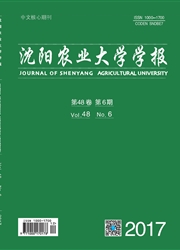

 中文摘要:
中文摘要:
为探讨植物-微生物联合修复佳乐麝香(HHCB)与镉(Cd)复合污染土壤技术的可行性及其相关修复土壤微生物群落多样性的变化,采用紫茉莉(Mirabilis jalapa L.)与孔雀草(Tagetes patula L.)两种植物配合HHCB降解菌,对HHCB,Cd 复合污染土壤进行联合修复研究,并使用变性梯度凝胶电泳技术(DGGE)在微观层面上进一步分析土壤微生物群落多样性的变化趋势.结果表明: 孔雀草对Cd 的富集效果要好于紫茉莉,且两种植物地上部分对于Cd 的富集效果更好.HHCB 含量的增加会导致降解菌的降解效率降低,在HHCB含量为100mg.kg-1时,最好的降解效果可达到63.58%,在HHCB含量为300mg.kg-1时,最好的降解效果达到55.3%.土壤中HHCB 的含量升高,其细菌种群多样性指数呈现降低的趋势,添加Cd 也会使其细菌种群多样性指数呈现降低的趋势,HHCB 与Cd 复合污染的细菌种群多样性指数低于HHCB 与Cd 单一污染的细菌种群多样性指数.研究结果为HHCB 与Cd复合污染土壤的植物一微生物联合修复提供了一条比较可行的方法并为进一步研究其微生物多样性变化提供了一定的理论基础.
 英文摘要:
英文摘要:
In order to explore the feasibility of bioremediation technology for contaminated soil by galaxolide (HHCB) andcadmium (Cd) with the plant-microbial combination, the jasmine (Mirabilis jalapa L.) and maidenhair (Tagetes patula L.), as wellas the galaxolide (HHCB) degrading bacteria had been used to remediate HHCB and Cd contaminated soil, and the dynamicchanges of the soil microbial community diversities were determinted with denaturing gradient gel electrophoresis (DGGE)technique.The results showed that the enrichment effect of maidenhair on Cd was better than that of purple jasmine, the aboveground parts of the two plants had better effect on the enrichment of Cd. The increase of HHCB content has led to thedegradation efficiency of degrading bacteria. The best degradation effect was 63.58% when HHCB content was 100mg.kg-1, andthe best degradation effect was 55.3% when HHCB content was 300mg.kg-1. The bacterial population diversity index showed adecreasing trend when the content of HHCB increased in soil. There was a decreasing trend of the bacterial population diversityindex in Cd pollution. Bacterial population diversity index in HHCB and Cd combined pollution was lower than that of HHCBand Cd single pollution bacterial population diversity index, which provides a feasible method for the combined remediation tothe HHCB and Cd contaminated soil.
 同期刊论文项目
同期刊论文项目
 同项目期刊论文
同项目期刊论文
 Toxicity assessment of simulated urban runoff containing polycyclic musks and cadmium in Carassius a
Toxicity assessment of simulated urban runoff containing polycyclic musks and cadmium in Carassius a Effects of roxithromycin on ammonia-oxidizing bacteria and nitrite-oxidizing bacteria in the rhizosp
Effects of roxithromycin on ammonia-oxidizing bacteria and nitrite-oxidizing bacteria in the rhizosp Influence of hydro-geomorphology, land-use and riparian zone characteristics on herbicide occurrence
Influence of hydro-geomorphology, land-use and riparian zone characteristics on herbicide occurrence ssDNA Aptamer-Based Column for Simultaneous Removal of Nanogram Per Liter Level of Illicit and Analg
ssDNA Aptamer-Based Column for Simultaneous Removal of Nanogram Per Liter Level of Illicit and Analg Changes of excitation/emission matrixes of wastewater caused by Fenton- and Fenton-like treatment an
Changes of excitation/emission matrixes of wastewater caused by Fenton- and Fenton-like treatment an Joint action and lethal levels of toluene, ethylbenzene, and xylene on midge (Chironomus plumosus) l
Joint action and lethal levels of toluene, ethylbenzene, and xylene on midge (Chironomus plumosus) l Biomonitoring persistent organic pollutants in the atmosphere with mosses: Performance and applicati
Biomonitoring persistent organic pollutants in the atmosphere with mosses: Performance and applicati Competitive adsorption and desorption of oxytetracycline and cadmium with different input loadings o
Competitive adsorption and desorption of oxytetracycline and cadmium with different input loadings o Humic acid acts as a natural antidote of graphene by regulating nanomaterial translocation and metab
Humic acid acts as a natural antidote of graphene by regulating nanomaterial translocation and metab Assessment of lead tolerance in 23 Chinese soybean cultivars and the effect of lead on their mineral
Assessment of lead tolerance in 23 Chinese soybean cultivars and the effect of lead on their mineral Occurrence, accumulation, attenuation and priority of typical antibiotics in sediments based on long
Occurrence, accumulation, attenuation and priority of typical antibiotics in sediments based on long Enhanced performance and capacitance behavior of anode by rolling Fe3O4 into activated carbon in mic
Enhanced performance and capacitance behavior of anode by rolling Fe3O4 into activated carbon in mic Effects of Fenton treatment on the properties of effluent organic matter and their relationships wit
Effects of Fenton treatment on the properties of effluent organic matter and their relationships wit Toxic effects of Hydrilla verticillata exposed to toluene, ethylbenzene and xylene and safety assess
Toxic effects of Hydrilla verticillata exposed to toluene, ethylbenzene and xylene and safety assess Concentration responses of toxicity sensor with Shewanella oneidensis MR-1 growing in bioelectrochem
Concentration responses of toxicity sensor with Shewanella oneidensis MR-1 growing in bioelectrochem Novel hydrated graphene ribbon unexpectedingly promotes aged seed germination and root differentiati
Novel hydrated graphene ribbon unexpectedingly promotes aged seed germination and root differentiati Accelerated OH- transport in activated carbon air-cathode by anchoring or mixing quaternary ammonium
Accelerated OH- transport in activated carbon air-cathode by anchoring or mixing quaternary ammonium Acute toxicity, biochemical and gene expression responses of the earthworm Eisenia fetida exposed to
Acute toxicity, biochemical and gene expression responses of the earthworm Eisenia fetida exposed to Interactions between graphene oxide and plant cells: Regulation of cell morphology, uptake, organell
Interactions between graphene oxide and plant cells: Regulation of cell morphology, uptake, organell Immobilized smart RNA on graphene oxide nanosheets to specifically recognize and adsorb trace peptid
Immobilized smart RNA on graphene oxide nanosheets to specifically recognize and adsorb trace peptid Physiological and molecular responses of the earthworm (Eisenia fetida) to soil chlortetracycline co
Physiological and molecular responses of the earthworm (Eisenia fetida) to soil chlortetracycline co A novel structure of scalable air-cathode without Nafion and Pt by rolling activated carbon and PTFE
A novel structure of scalable air-cathode without Nafion and Pt by rolling activated carbon and PTFE 期刊信息
期刊信息
